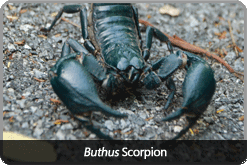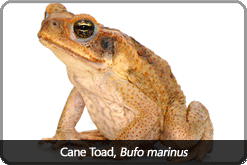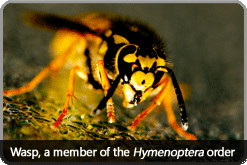There are many animals and insects around the world which use toxins, both for defence and for predation.

The scorpion is a predatory arachnid, and is easily recognised by its front claws and the distinctive tail, which has the stinger (also called a telson) attached. Although all scorpions are venomous, and use their venom to catch their prey by paralysing them, there are only a few (around 25) species that have venom strong enough to actually harm or kill a human. Most of these, and all of the deadly ones, are of the Buthidae family – which are found in the Mediterranean area and are recognisable as they have triangular sternums. Scorpions also use their venom as a defence when they feel threatened and during mating. Their venom is, like many others, a combination of different compounds that when brought together are toxic to the targeted organism. The most common effects of envenomation include local tissue inflammation as well as neuromuscular effects. How quickly symptoms appear depend on the potency of the venom injected and how close to the bloodstream the entry site was.
Some butterflies, such as the Monarch butterfly, are also slightly poisonous due to the fact that they ate poisonous plants like milkweeds during their development, as caterpillars. They are never toxic enough to cause the death of an animal, but the toxin tastes terrible and anything, for example a bird, that attempts to eat one once will be deterred from doing so again. Because of the protection that being poisonous provides, other non–poisonous butterflies often choose to mimic the patterns on those that are (bright colours and eyes), in order to gain the same protection.

The cane toad (Bufo marinus) is a large toad that lives on land and is native to the Americas and was introduced to Australia to deal with pests (although now it has become a pest itself). This species produces toxins (bufotoxins) in parotoid glands on its neck, which are secreted as a milky looking liquid when the toad feels threatened, by a predator for example. The skin of the toad is also toxic, and can prove fatal to some mammals, even humans, if ingested. Cane toad venom will mainly affect the heart. The main component of the toxins secreted, bufotenin, will cause hallucinations – hence the activity of toad licking, although this can sometimes result in serious illness – and this chemical is actually illegal.
Poison dart frogs are native to the South American continent, and are very brightly coloured and patterned, indicating their toxicity to other animals who might wish to prey on them. Although some species of poison dart frogs are more toxic than others, they all have a degree of toxicity in their skin, and their poison is often used by those indigenous to the areas the frogs are found in to tip darts and spears, making them poisonous. For the frog, as for the people who use the toxins in their weapons, the poison of these species of frog is for defence. Recent research has shown the possibility for the toxins extracted from these frogs to have some medicinal benefits: among the proposed uses are painkillers more powerful than morphine and appetite suppressants.


The Ornithorhynchus anatinus (platypus) is a semi–aquatic mammal and one of five surviving species of monotreme. It is also the only egg-laying mammal that exists. All platypuses are born with small, hollow spurs on their hind legs, but they only connected to venom glands and produce venom in the males. The female's spurs will drop off by the time they are one year old. This venom is made up of proteins that are only found in the platypus, and together are powerful enough that they can kill animals like dogs and cause great pain to humans. As this venom only seems to be produced around their reproductive season, it may be a mechanism used to fight other males to secure their place with a female as well as to fight off predators. Recent research has suggested that platypus venom may have a use in pain relief and antibiotic production.
The tarantula is a large hairy spider (arachnid) which is mildly venomous. All species of tarantula are venomous, but none have yet been known to bite and kill a human. Most bites are about the same as a wasp or bee sting in terms of pain and reaction, with one African species also bringing on hallucinations in some victims. Other compounds are also injected with the toxins, and it is this that sometimes causes allergic reactions. Urticating hairs are also fired into the air when the spider squirts venom, and these can cause problems for humans if they get in the eyes.

Shrews are small mammals that have an unusual characteristic, like the platypus: some species of shrew have venom, which is found in their teeth. This toxin is useful when the shrew is looking for prey – it can kill mice easily after a short amount of time once bitten. Once again, there are potential uses for this toxin in the medical world. This includes the extraction of one of the compounds from the venom to be used to lower blood pressure in patients with hypertension.
Wasps, ants and bees are all members of the order Hymenoptera. Females usually have an ovipositor, which is a long, thin, hollow structure used to lay eggs. However, in some species, this tube has developed into a sting with a gland at its base, which will inject a toxin into the victim when the insect is provoked. In insects like wasps and bumblebees, there is a smooth sting with no barbs, so it can sting repeatedly. Other bees, such as honey bees, have barbed stings and this breaks off in the victim when it penetrates and the bee will die. Unless allergic to the sting, most humans will find these stings painful but not a danger to health. For ants, their stings squirt an acid, formic acid, into their victim.

